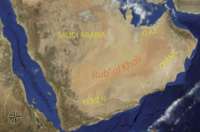
Photo from wikipedia
Abstract The Triassic-Jurassic boundary is marked by one of the ‘big five’ mass extinctions of the Phanerozoic. This boundary event was accompanied by several carbon cycle perturbations, potentially induced by… Click to show full abstract
Abstract The Triassic-Jurassic boundary is marked by one of the ‘big five’ mass extinctions of the Phanerozoic. This boundary event was accompanied by several carbon cycle perturbations, potentially induced by the opening of the Central Atlantic and associated volcanism, and accompanied by an ocean acidification event. Continuous carbonate successions covering this interval of environmental change are however rare. Here data from a shallow-marine equatorial mixed carbonate-siliciclastic succession is presented, that was studied on a regional scale. Four sections that are 48 km apart were examined on the Musandam Peninsula (United Arab Emirates and Sultanate of Oman). The system was analysed for its sedimentology, vertical and lateral facies changes, and stable carbon and oxygen isotopes. Strontium isotope analysis was used to determine the position of the Triassic-Jurassic boundary horizon. The studied ramp experienced an episode of demise during the Late Triassic, followed by a restricted microbialite dominated ramp, containing large amounts of siliciclastic facies. During the Latest Triassic the diverse carbonate factory revived and flourished across the Triassic-Jurassic boundary. No clear evidence for a biocalcification crisis or an ocean acidification event across the Triassic-Jurassic boundary is visible. Lateral facies heterogeneities can be observed across the studied interval, attributed to hydrodynamic activity, including tropical storms, crossing the extensive shelf area. Although evidence for synsedimentary tectonic activity is present, the vertical stacking pattern is largely controlled by changes in relative sea level. The refined chronostratigraphy accompanied by the detailed environment of deposition analysis allows for a refinement of the regional palaeogeography. The neritic equatorial carbonate ramp has archived a negative carbon isotope excursion preceding the Triassic-Jurassic boundary that has also been reported from other study sites. The lack of evidence for a biocalcification crisis across the equatorial Triassic-Jurassic boundary indicates that the Tethys did not experience a distinct global acidification event.
Journal Title: Gondwana Research
Year Published: 2017
Link to full text (if available)
Share on Social Media: Sign Up to like & get
recommendations!